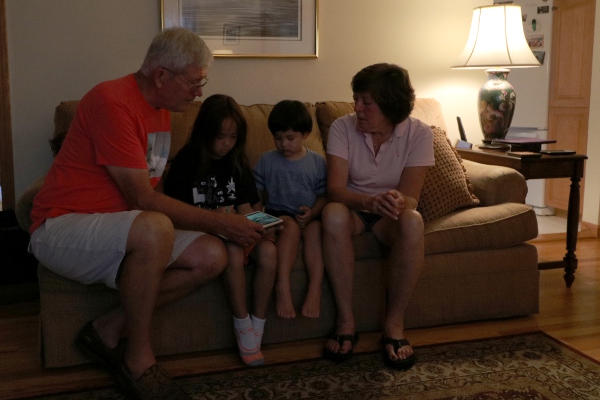It's Labor Day weekend here in the US, so we've come down to my parents' for an end-of-summer weekend. The kids are, of course, thrilled to be visiting Grandma and Grandpa's house where they can bask in the warmth of... Transformers cartoons on Grandma and Grandpa's Netflix subscription.
(I'd say "Kids these days," but if I'm totally honest, I would have to admit that getting to watch WPIX was a highlight of visits to my grandmother on Long Island back when I was their age...)
Anyway, a lot of the pictures I end up taking look basically like this: quick snapshots of the kids doing whatever. In this case, having Grandma and Grandpa make cartoons play on the tablet. Part of this photo-a-day business is to push a little past that routine, but at the same time, there's a lot to be said for sticking with what works...
(This one took a bit of processing in GIMP, because the lamp on the right cast everything else in deep shadow. A version with the flash on was a little too flat, though, and anyway, the Curves tool is a wonderful thing.)
Anyway, if you're in the US, enjoy the holiday weekend. If not, um, happy September.


Re: that last parenthetical, you can dial back the flash. Look for a +/- with a lightning bolt (don't know if it's in a menu or a dedicated button on your camera). You can use that to dial back the flash exposure by a stop or two. It'll add fill flash without overwhelming the natural light, to prevent the flatness of using full-power flash.
You can just pick up a scrap of paper and hold it in front of the flash and it will tone it down when you need a fill light. Fun to experiment with whatever piece of paper is handy.
I was going to suggest what Phil said. Directing the flash back to the wall behind you might do the trick. The other is to force the lamp to be overexposed. It is easier to get rid of some too-bright bits than bring out the last few bits of info you have about the too-dark image. Can your camera show you the light curve or select the region used to set the exposure? If not, a different +/- button can shift the exposure away from what it normally does. Just be sure to reset it.
But I like the "natural" interior light over a direct flash. In olden days they would be lit by the blue glow from one them there cathode ray TVs, which made for great photos.